Lucerne, Switzerland - Day 14
|
|
At some point on day 13 I came down with a bug. I wasn't the only one. That day the Ama Prima stopped in Breisach, Germany. I missed the excursion but Lynnette was able to go on a hike through the Black Forest which she enjoyed. As with most other places we stopped, you could also go on a bike tour or a wine tour if you wanted.
We woke up on day 14 tied up in Basel, Switzerland which is generally considered the end of the line for the Rhine River. I gathered the impression that it is like an inland industrial port. I found out later it is the third largest city in Switzerland, with things to do including a large art museum, but we were headed for Lucerne, Switzerland's tourism capital.
|
| |
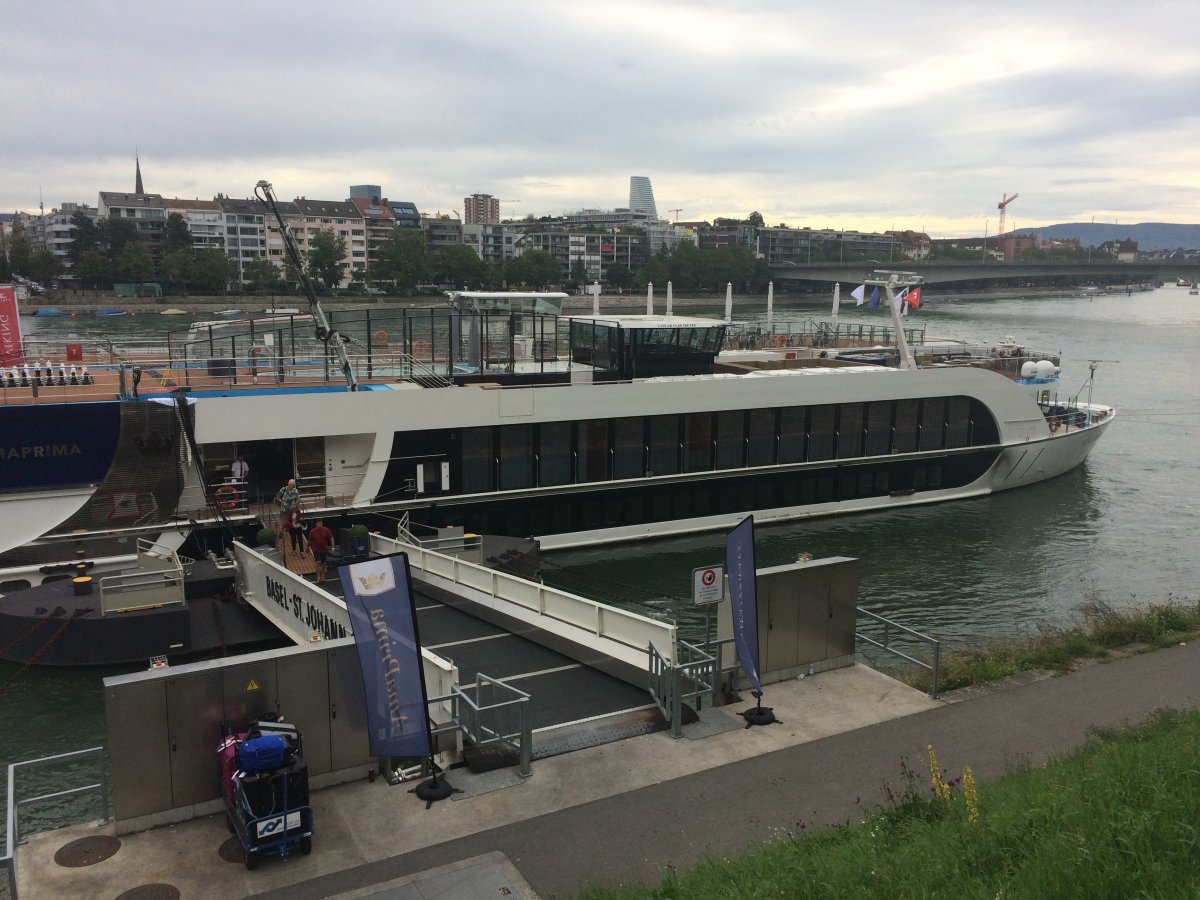 |
|
|
We disembarked the Ama Prima for the last time. It's funny -- on a cruise boat for a week you get into a routine, get to know others, and it becomes your home. But then suddenly you pack your bags, get off the boat, say goodbye to your new friends, and it's over. You are on the road again.
Originally we had planned to take the local tram to the train station but we ended up sharing a cab with another couple. It was just easier and didn't cost much. The train station was at first overwhelming. But we found a Tourist Information Office where they spoke english and were able to buy our train tickets to Lucerne there. It was a pleasant hour-long train ride to Lucerne.
|
| |
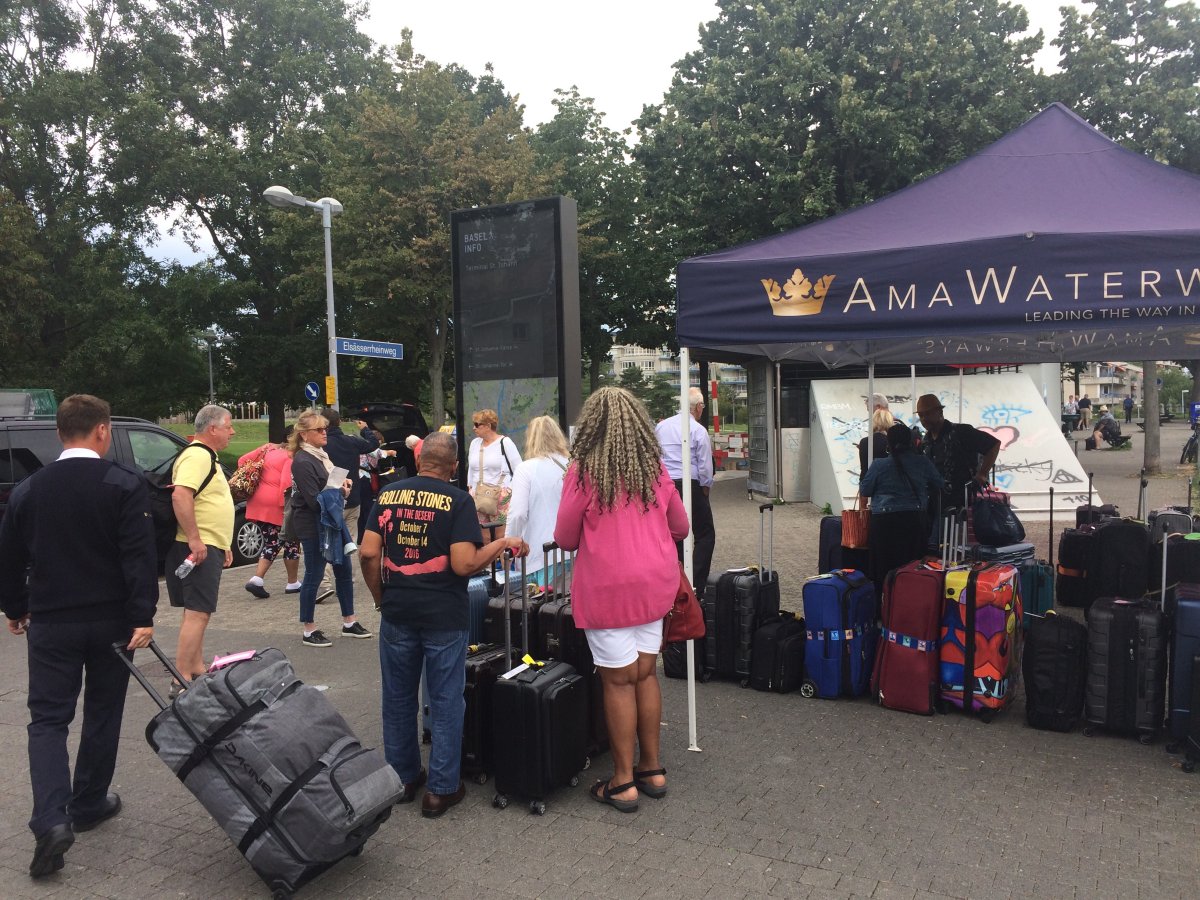 |
|
|
The train station -- the Bahnhofplatz -- was right there in Lucerne. Very nice, very modern -- built in 1971 -- very convenient to everything in Lucenere. Our B&B Hans im Loechli was out of town in nearby Littau and we still had the day to sightsee, so we put our bags in a locker at the train station, and headed into town to see the sights. Lucerne isn't that big and you can walk to everything. We used the Rick Steves's walking tour as a guide.
Here is our first sight of one of Lucerne's historic wooden bridges over the Reuss River which flows out of big Lake Lucerne and right through town. This is the famous Chapel Bridge, Lucerne's most famous landmark. Notice how it is covered with a thatched roof and has the octagonal stone Water Tower -- built around 1300 -- on the left. Believe it or not, in 1993 a leisure boat moored under the bridge caught fire and much of the bridge was burned. It was rebuilt but many of the paintings in the overhead roof are recreations.
|
| |
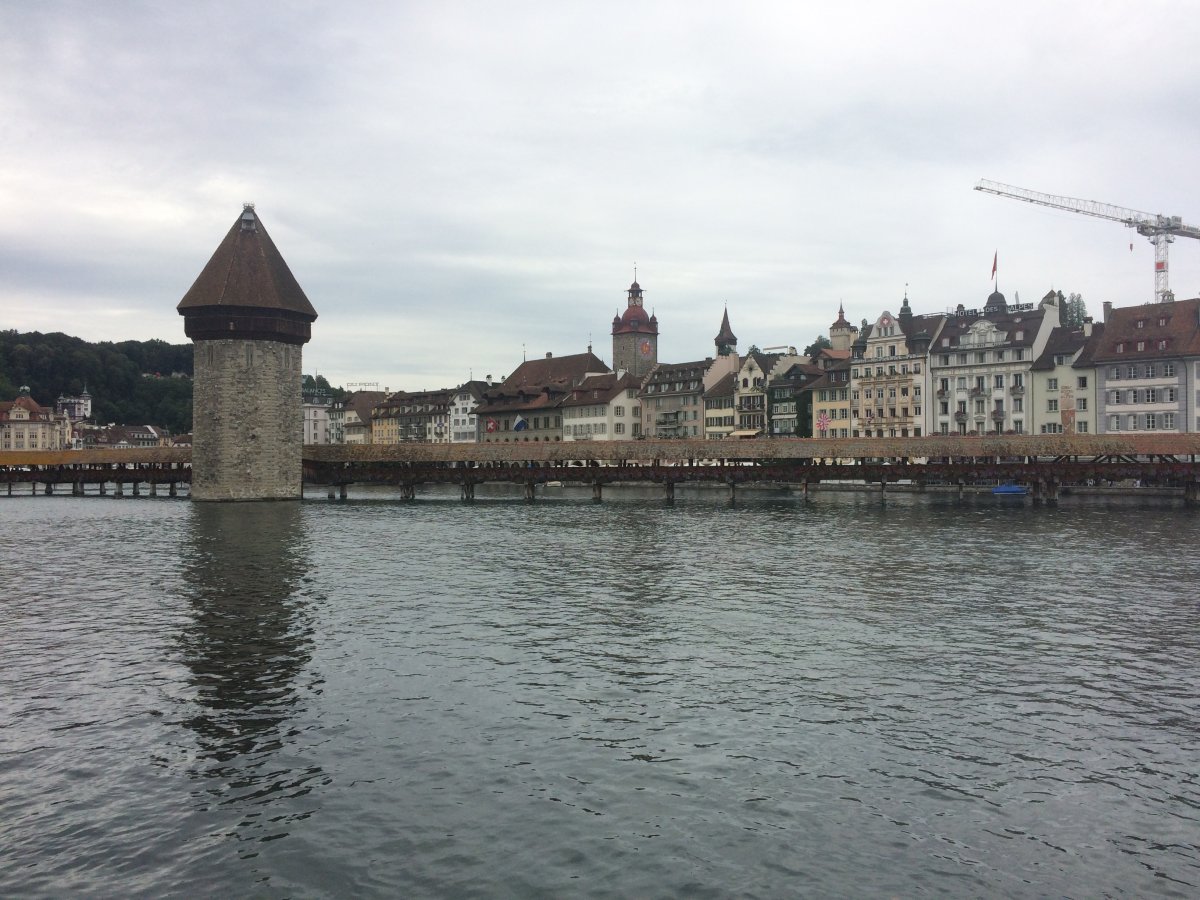 |
|
|
Looking back at the second bridge over the Reuss River, the Rathaus Bridge.
|
| |
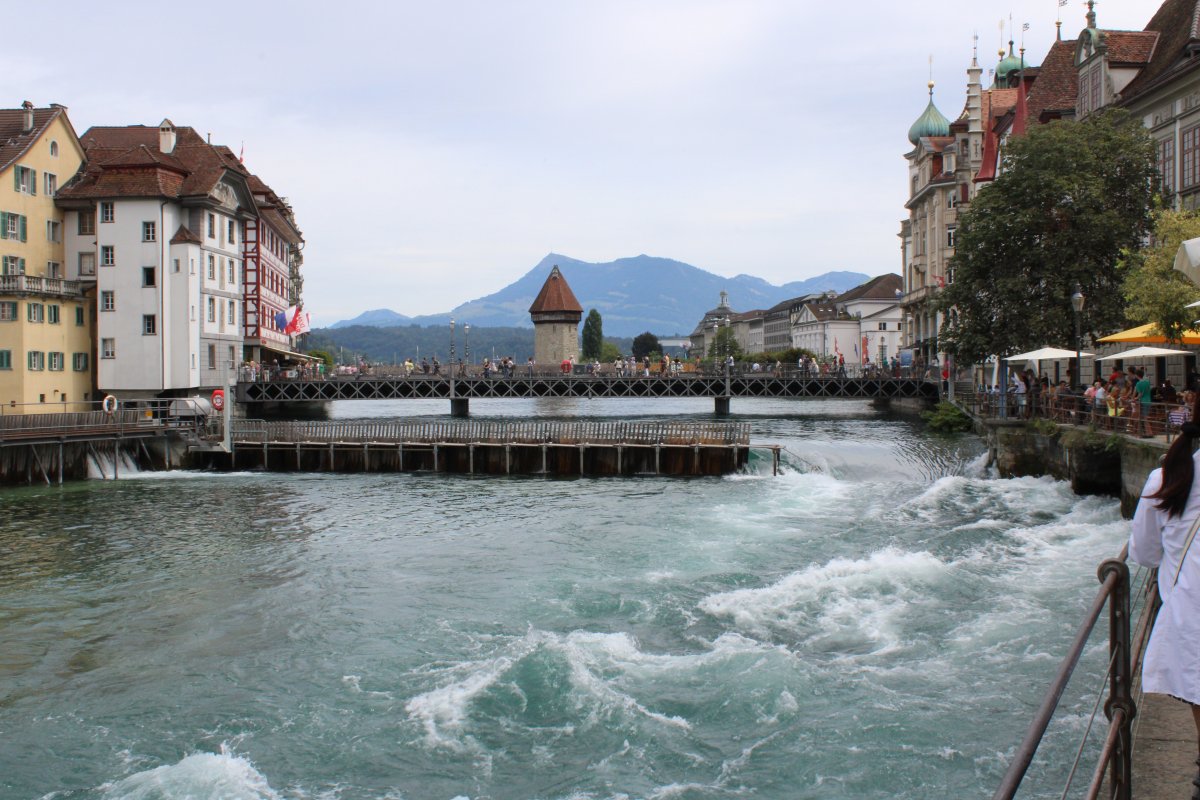 |
|
Now looking at the third bridge: the Mill Bridge. Unlike the Chapel Bridge, it is original -- never burned down.
|
| |
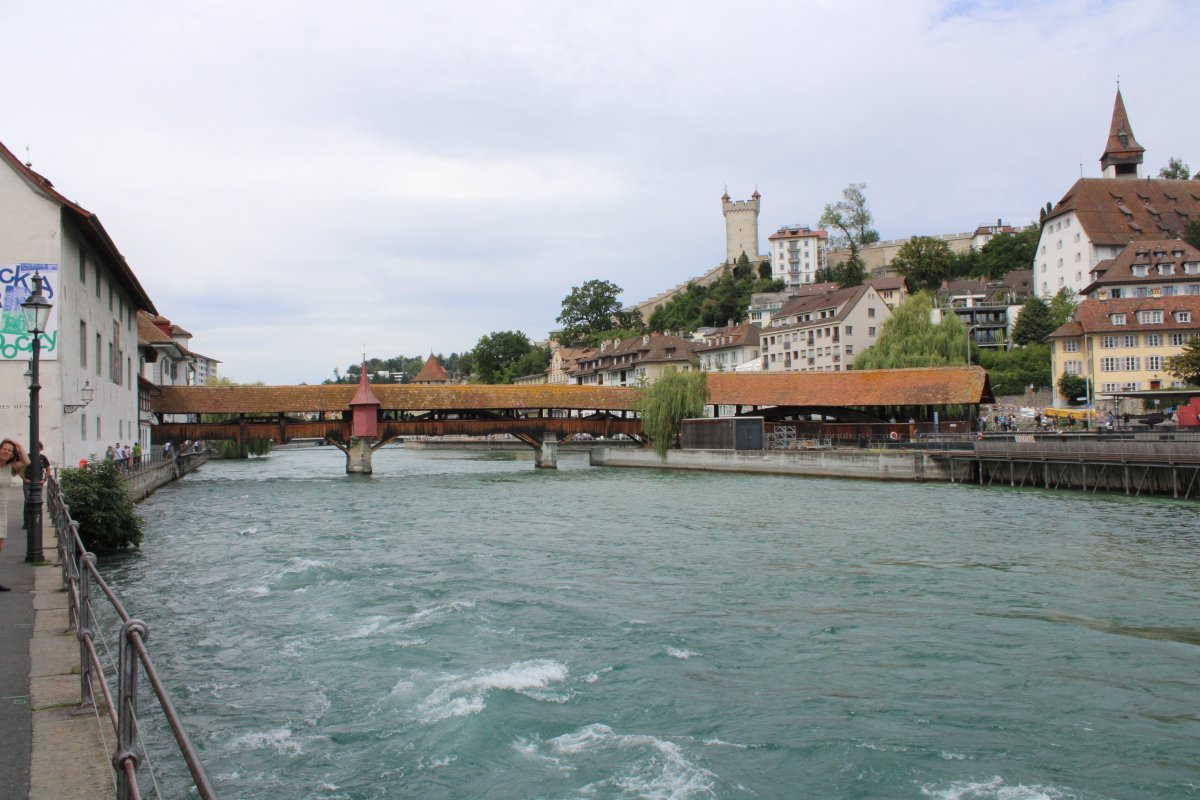 |
|
| Walking out onto the Mill Bridge. Notice the paintings overhead. These were done in the 17th century. The coats of arms on the paintings are those of the aritocratic families that sponsored them. |
| |
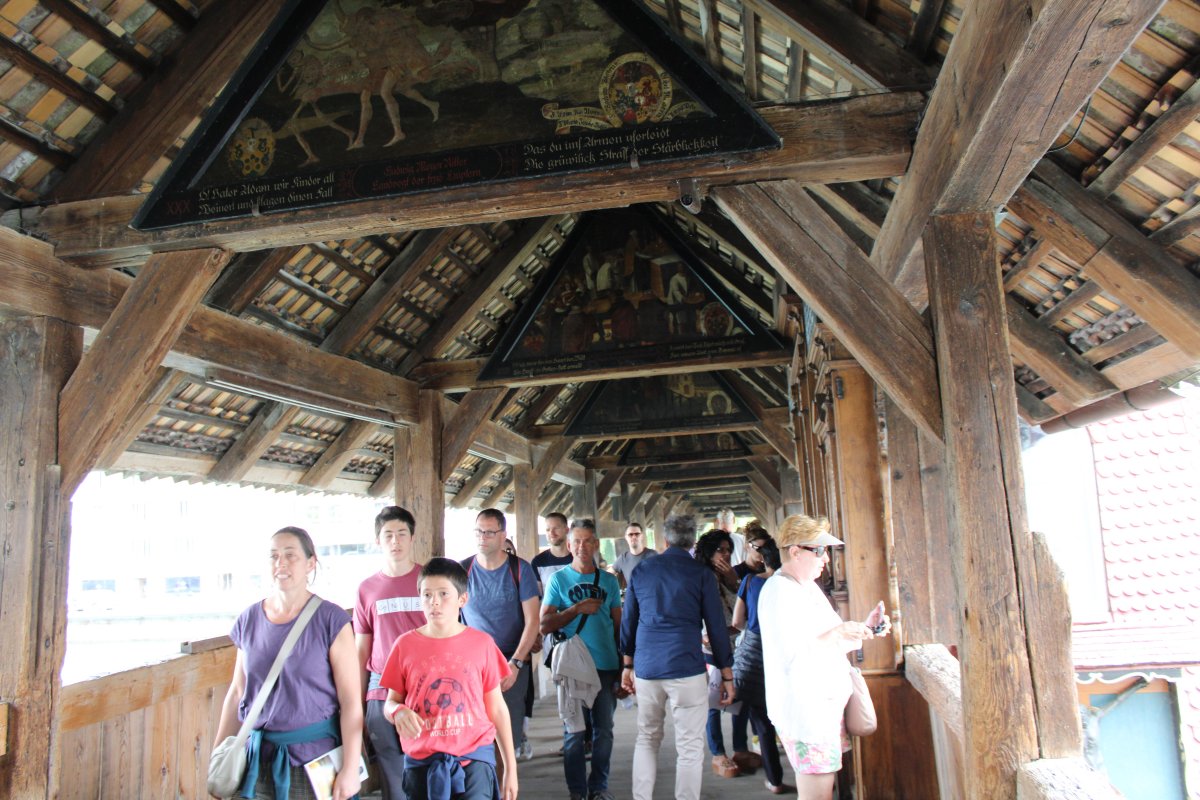 |
|
| The Mill Bridge and the Chapel Bridge were part of the city fortifications. |
| |
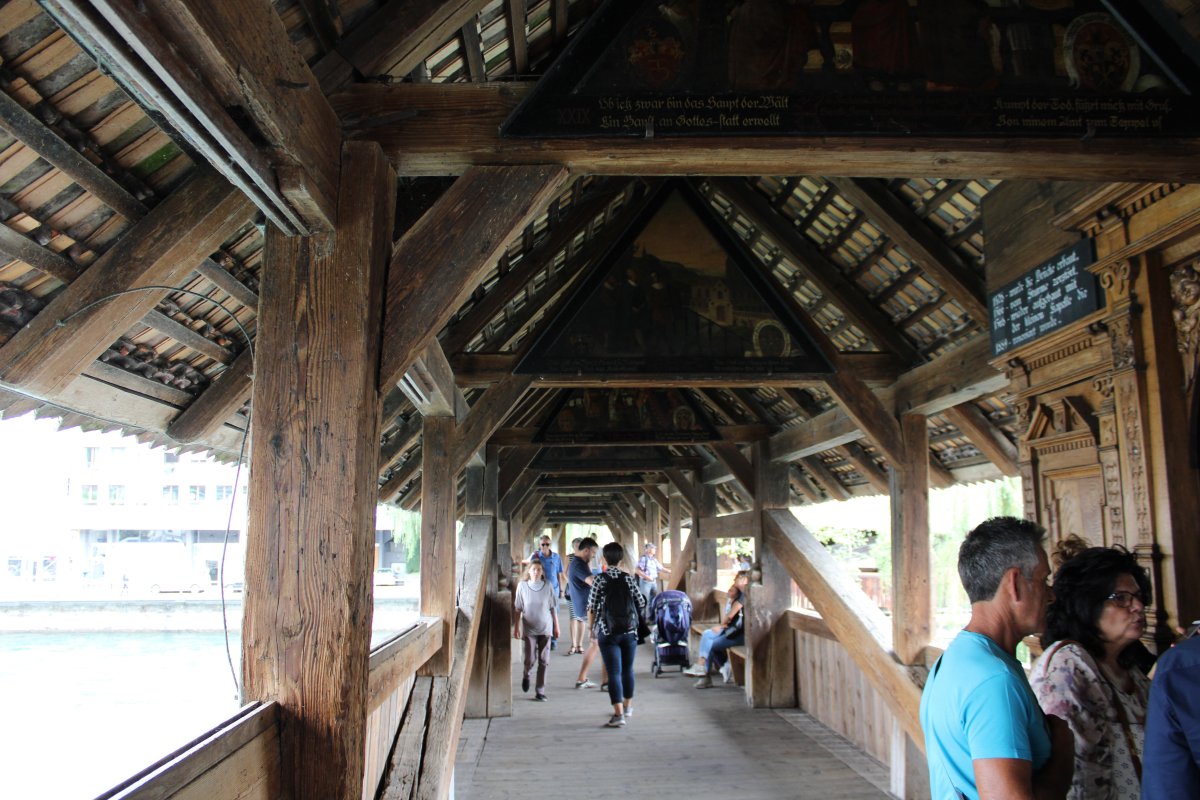 |
|
|
This little chapel halfway across the Mill Bridge has been here since the 16th century! A line of family crests on the door frame acknowledges the volunteers who have kept the chapel decorated according to the season.
|
| |
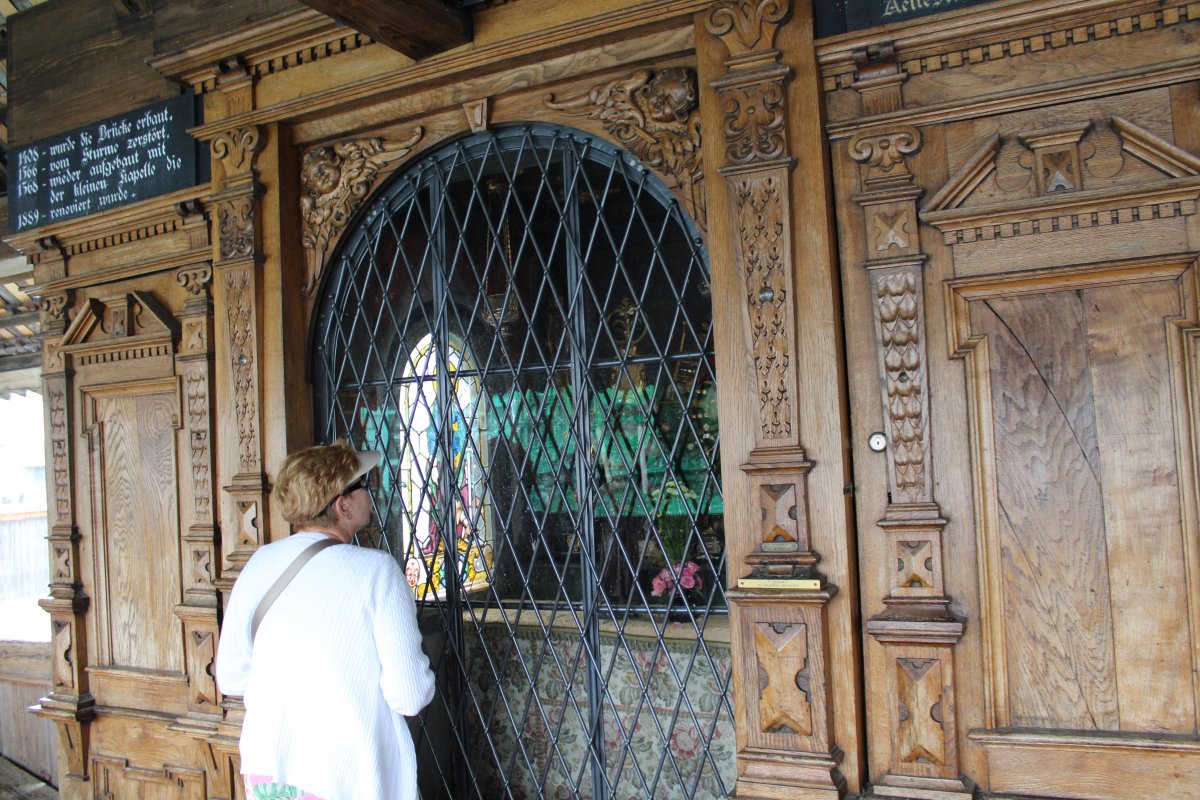 |
|
| At one time three mills churned grain here. Now, unseen, a moern hydroelectric plants generates power. |
| |
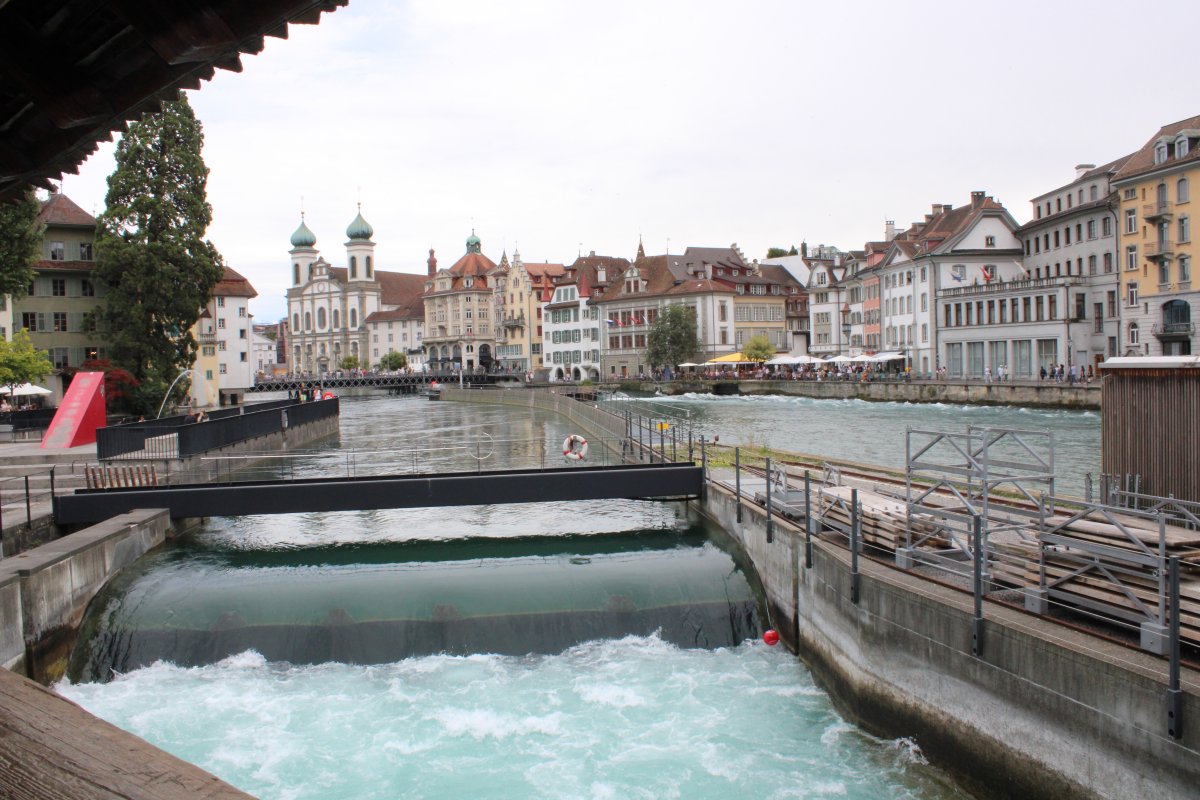 |
|
|
The Weinmarkt. In medieval Lucerne, this square was a marketplace for wine.
Every building in the old town -- whether new or rebuilt -- is required to offer residential apartments to prevent the historic zone from becomeing only office space and touristy shops. Good policy!
|
| |
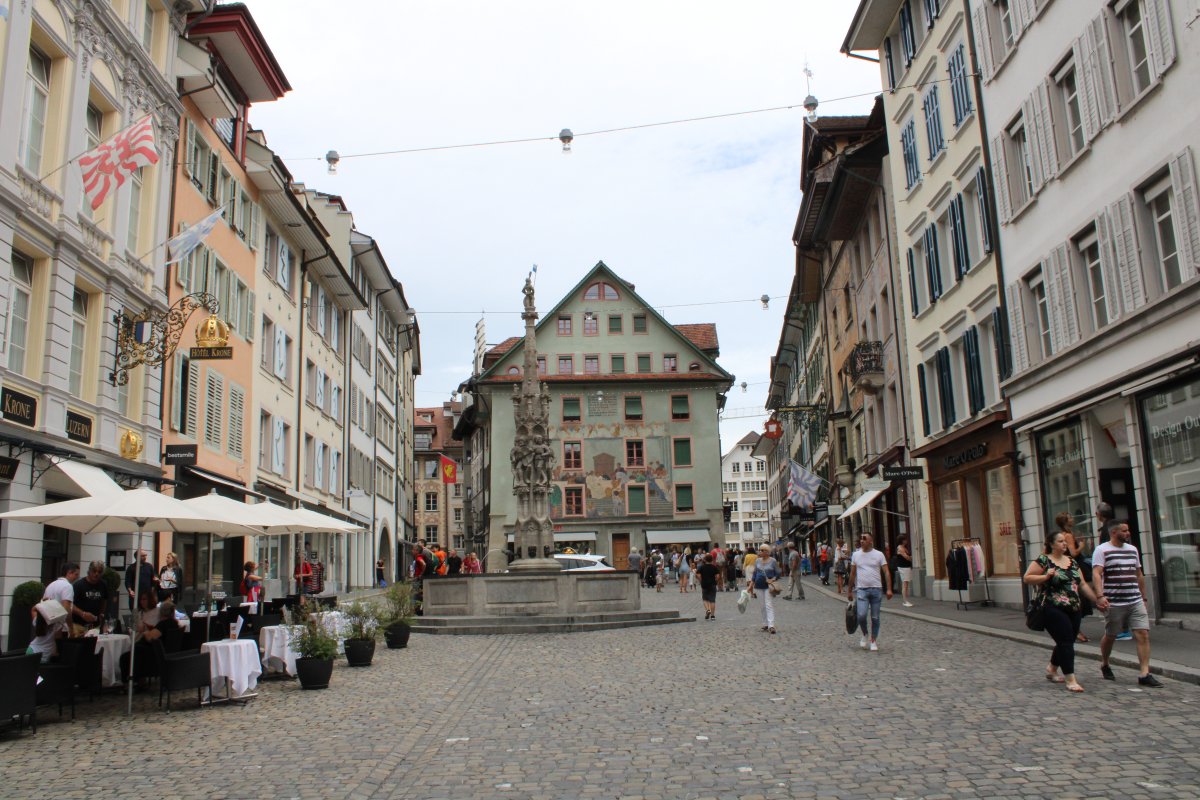 |
|
| |
| |
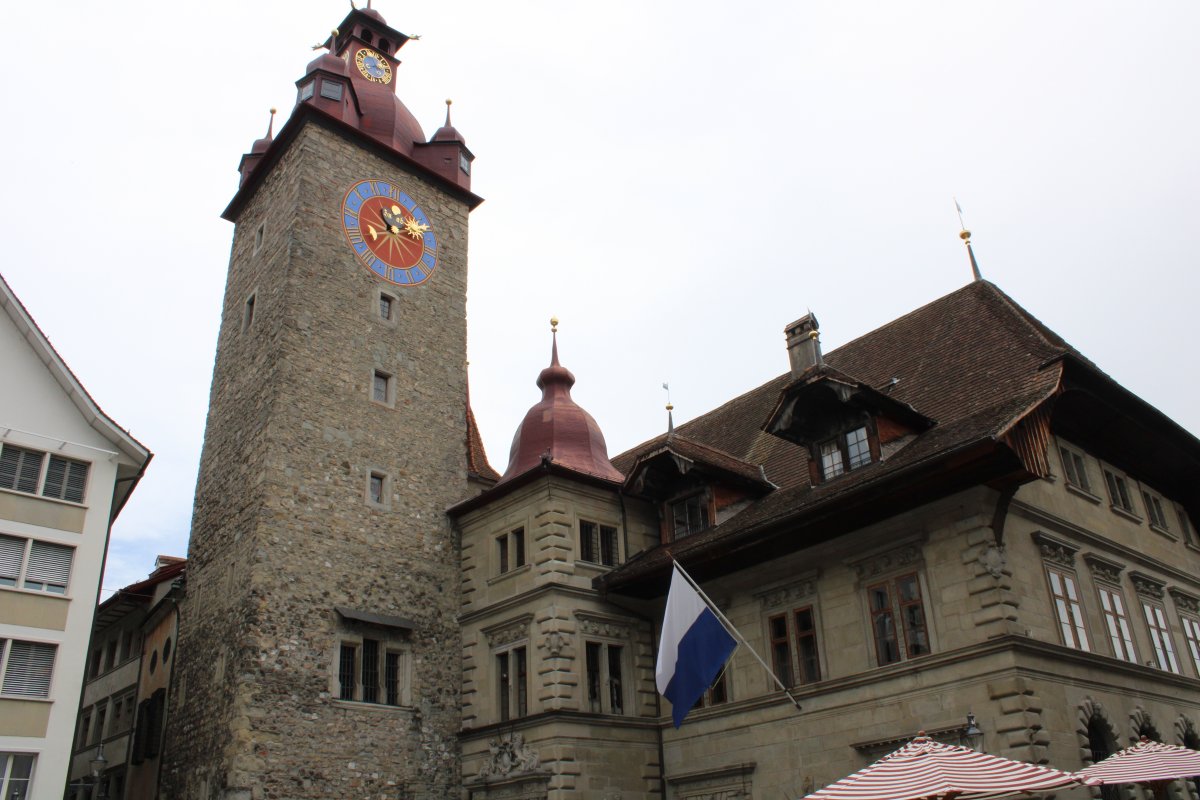 |
|
| We walked around trying to find the Old Town Wall. |
| |
 |
|
| After a good deal of walking and climbing stairs, we found it. Now we are walking along the top of the wall. |
| |
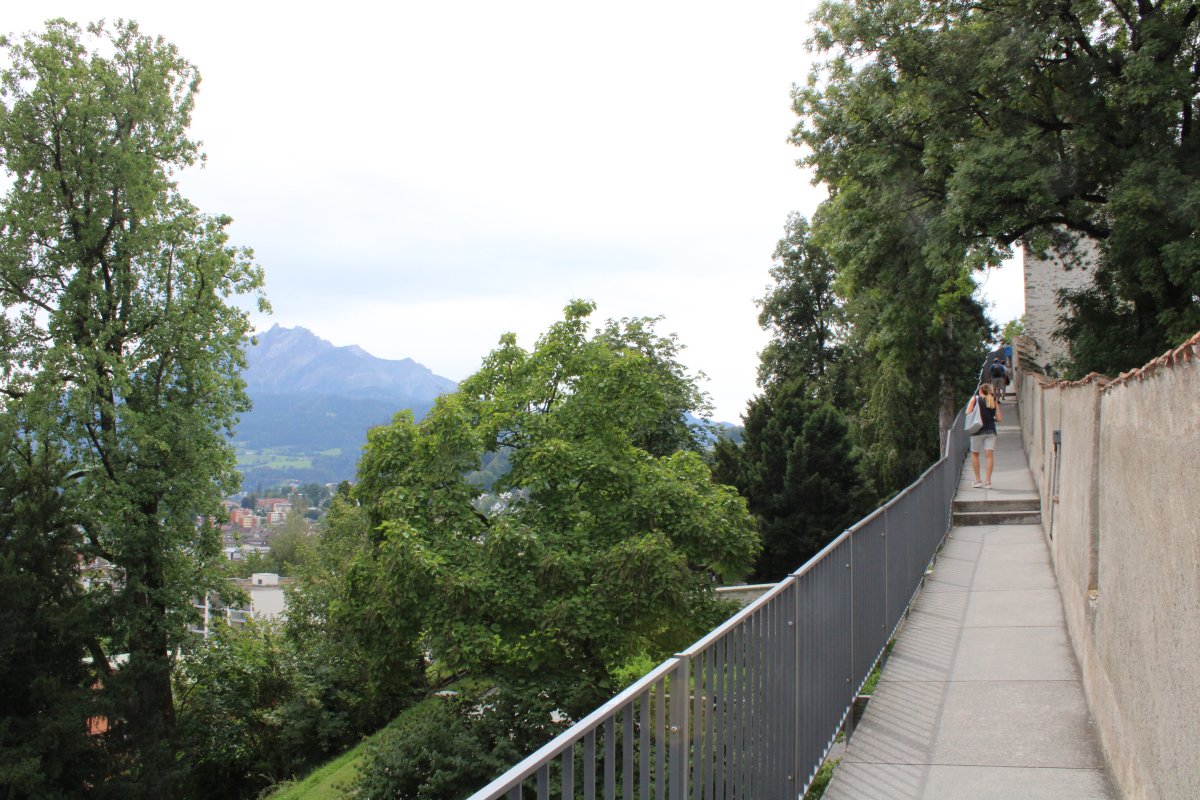 |
|
|
Looking east out over just the west end of Lake Lucerne.
|
| |
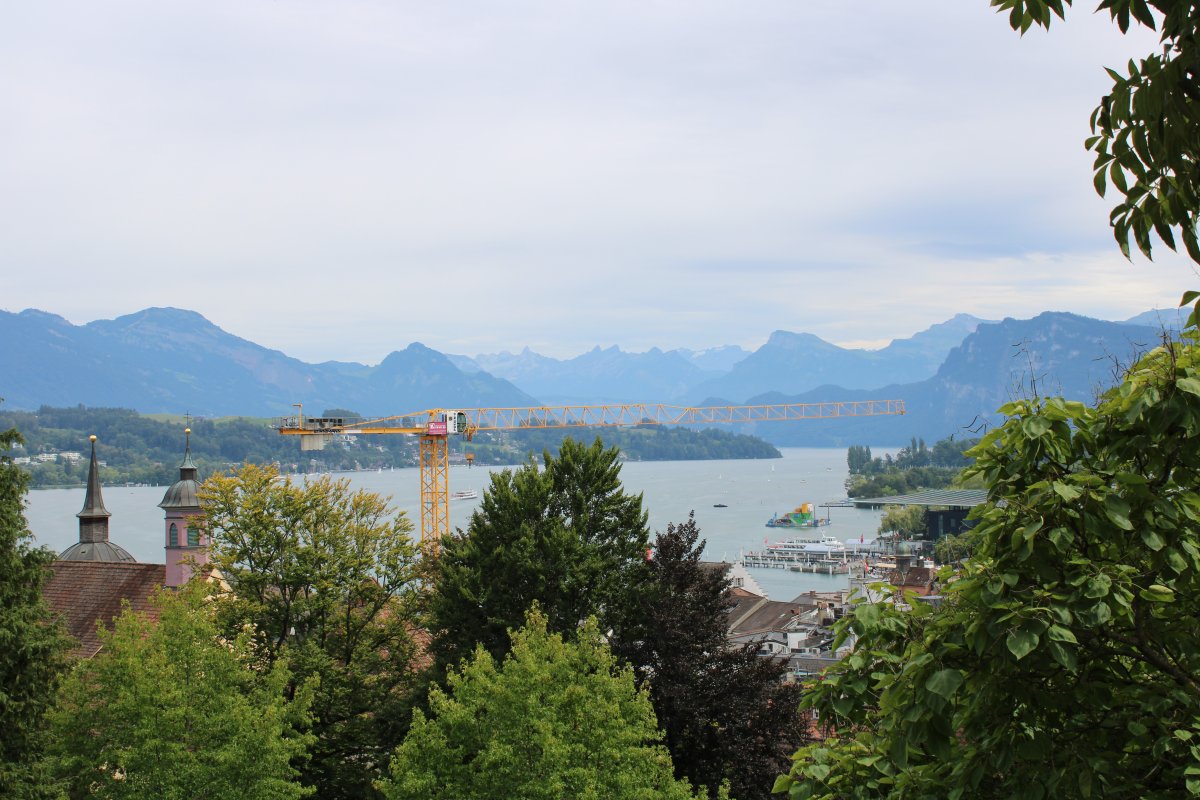 |
|
| Looking south at Mount Pilatus. This is where we would go tomorrow. |
| |
 |
|
|
Looking at the east part of Lucerne.
|
| |
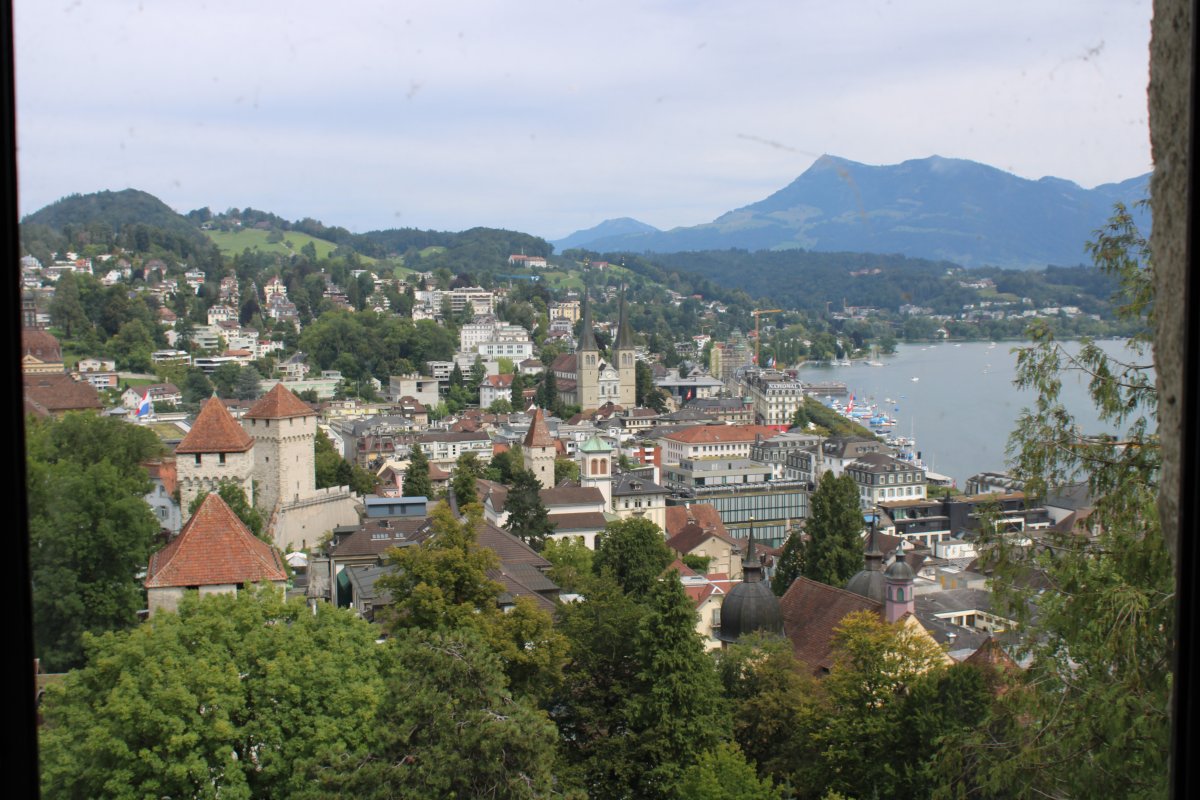 |
|
| We climbed one of the walls observation towers. Here, I'm looking down at the wall. |
| |
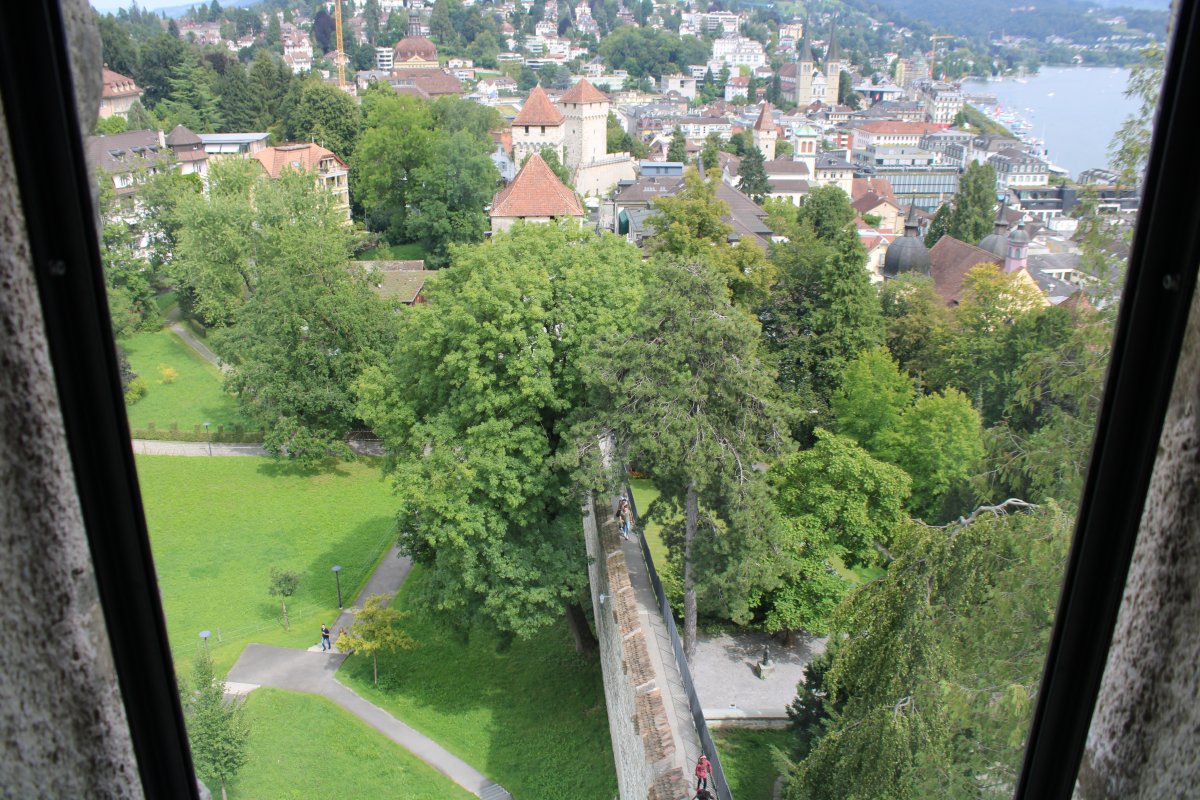 |
|
| Looking north away from old town. |
| |
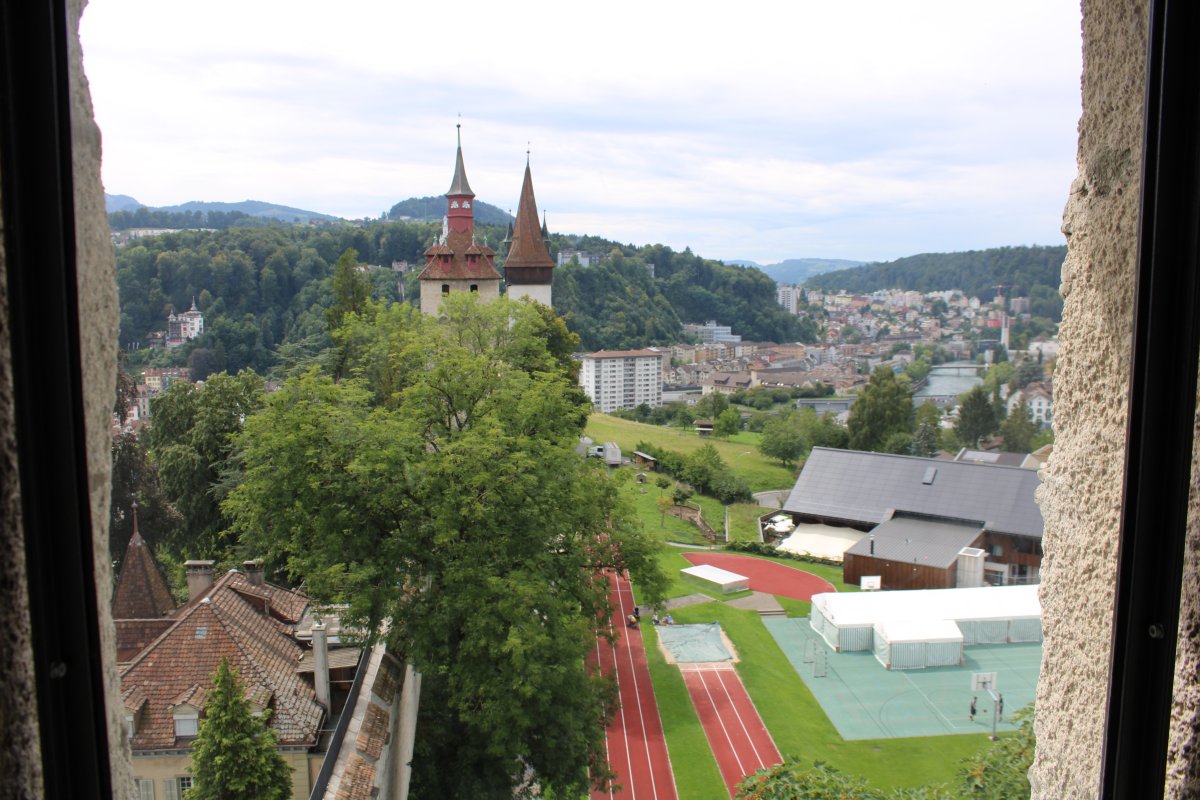 |
|
| A great town of Lucerne with the Lake and surrounding mountains to the east. The Bahnhofplatz (train station) is center right. A big stone arch is visible in front of it. This arch was the entrance to the old train station built in the late 1800s. To the left of the train station is the modern Culture and Conference Center that has a concert hall. To the left of that is the dock where you board the boats to go on on the lake. |
| |
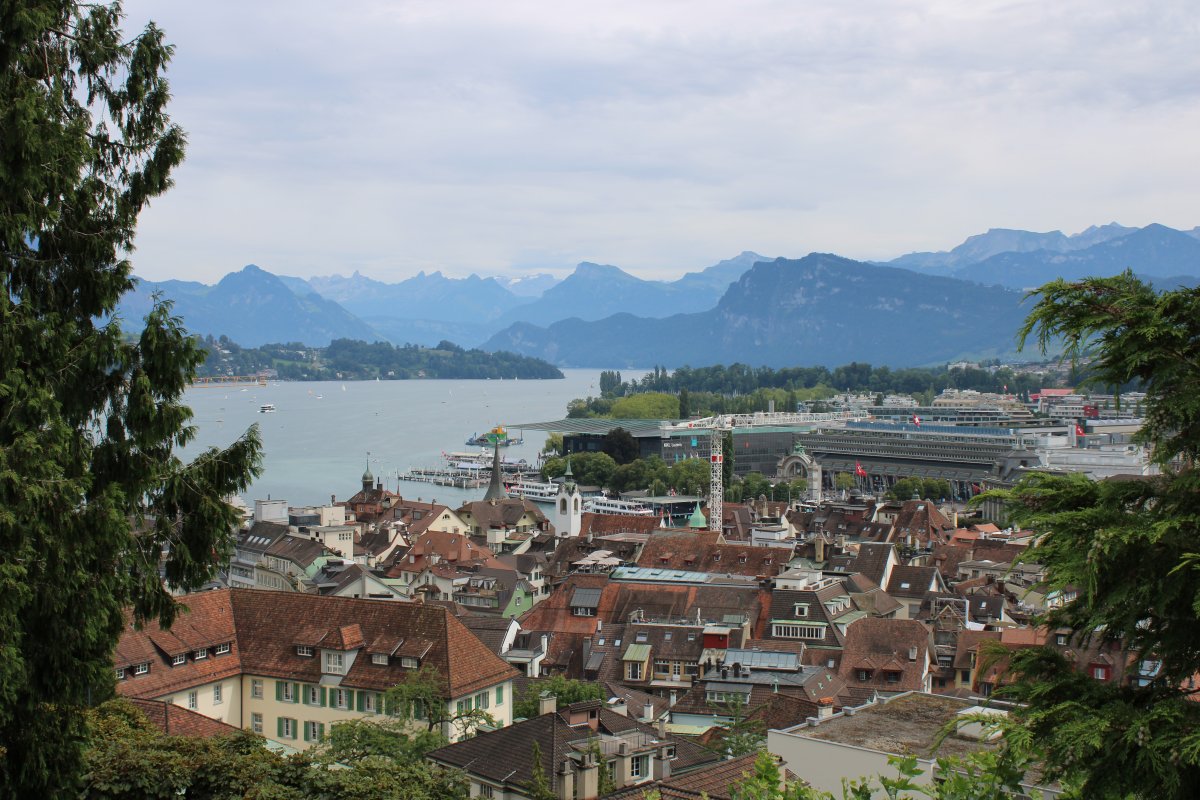 |
|
|
A close up of the train station and big stone arch.
|
| |
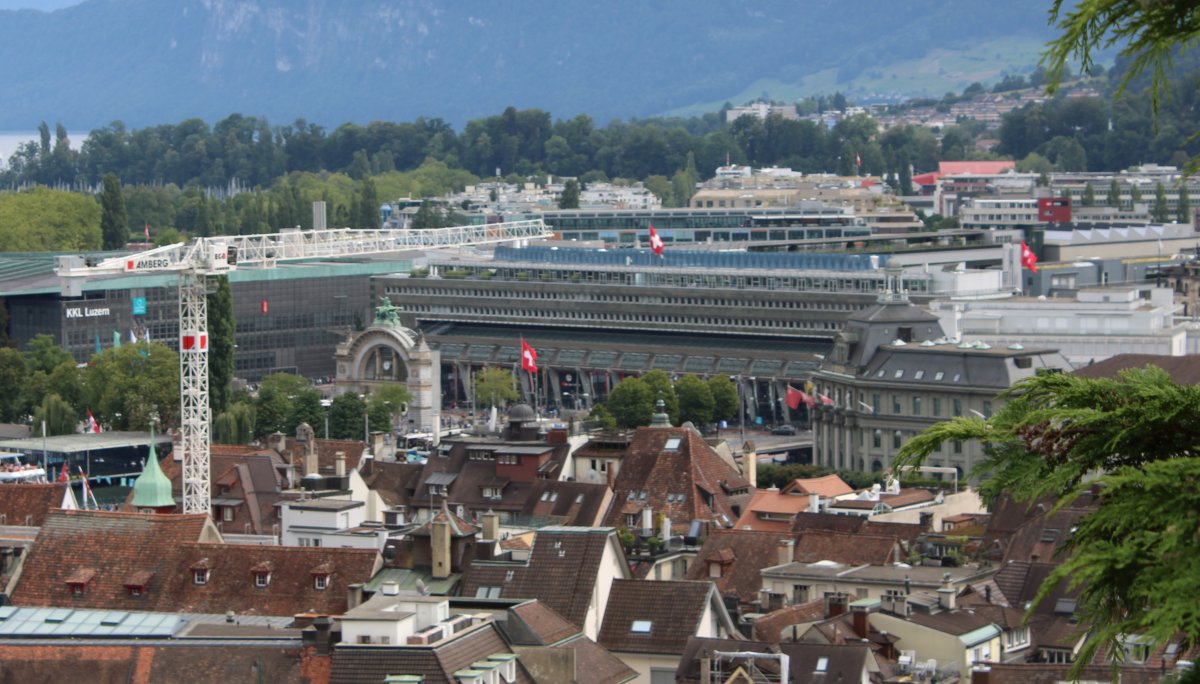 |
|
| The observation tower we just finished climbing. |
| |
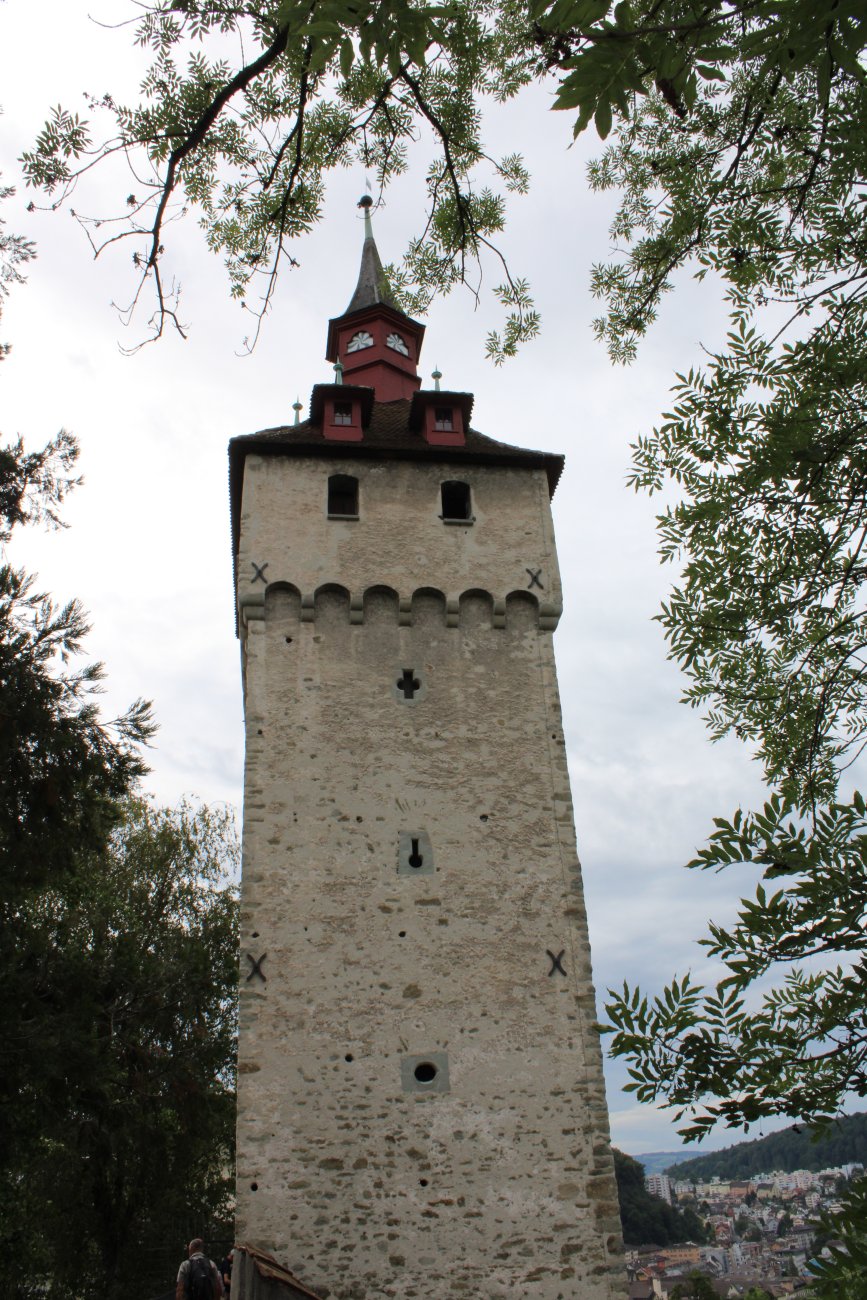 |
|
We walked to the northeast part of town to see the famous Lion Monument. I was thinking it was farther away, and had no idea what to expect, but we rounded a bend and there it was! It's a carving of a mortally wounded lion in the side of a granite cliff. It looks small here but the sculpture is actually very large: 33 feet long and 20 feet tall. It was designed by Bertel Thorvaldsen and hewn in 1820–21 by Lukas Ahorn. It commemorates the more than 600 Swiss Guards who were massacred in 1792 during the French Revolution, when revolutionaries stormed the Tuileries Palace in Paris. It is one of the most famous monuments in Switzerland, visited annually by about 1.4 million tourists.
The inscription reads, Helvetiorum fidei ac virtuti -- "To the loyalty and bravery of the Swiss."
|
| |
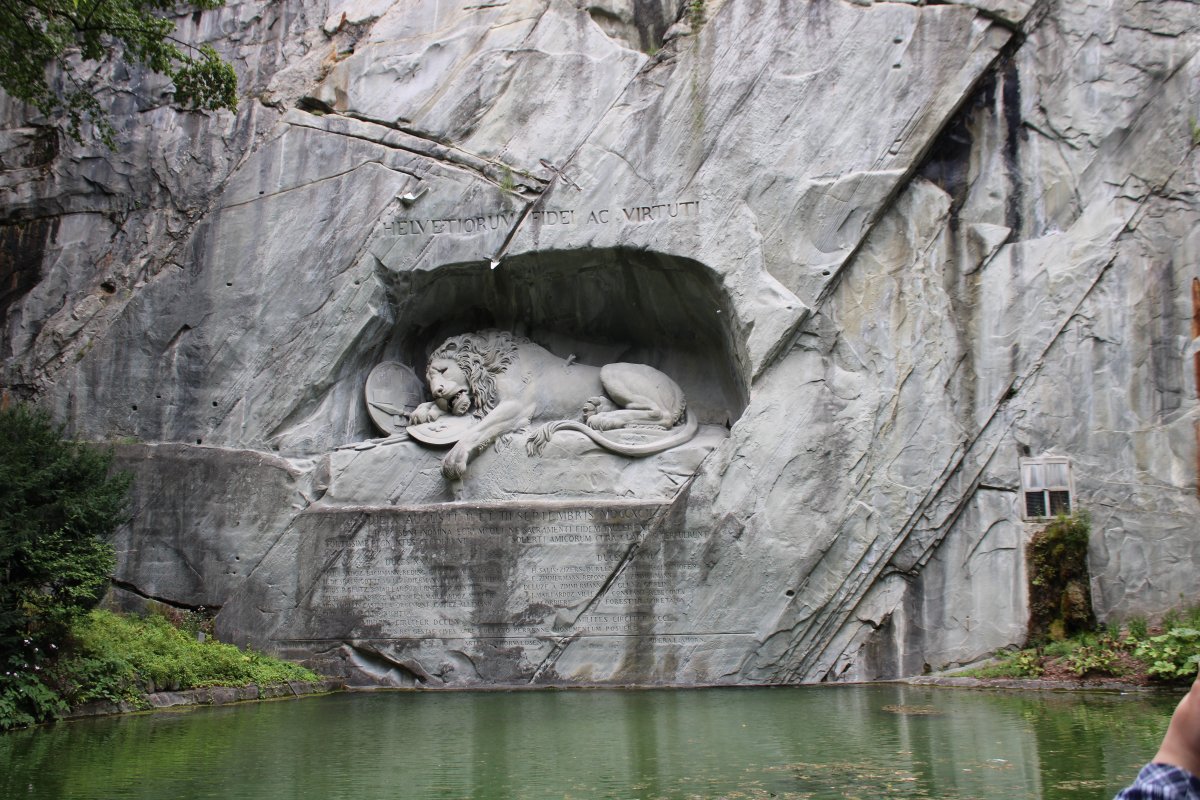 |
|
|
The dying lion is portrayed impaled by a spear, covering a shield bearing the fleur-de-lis of the French monarchy; beside him is another shield bearing the coat of arms of Switzerland.
|
| |
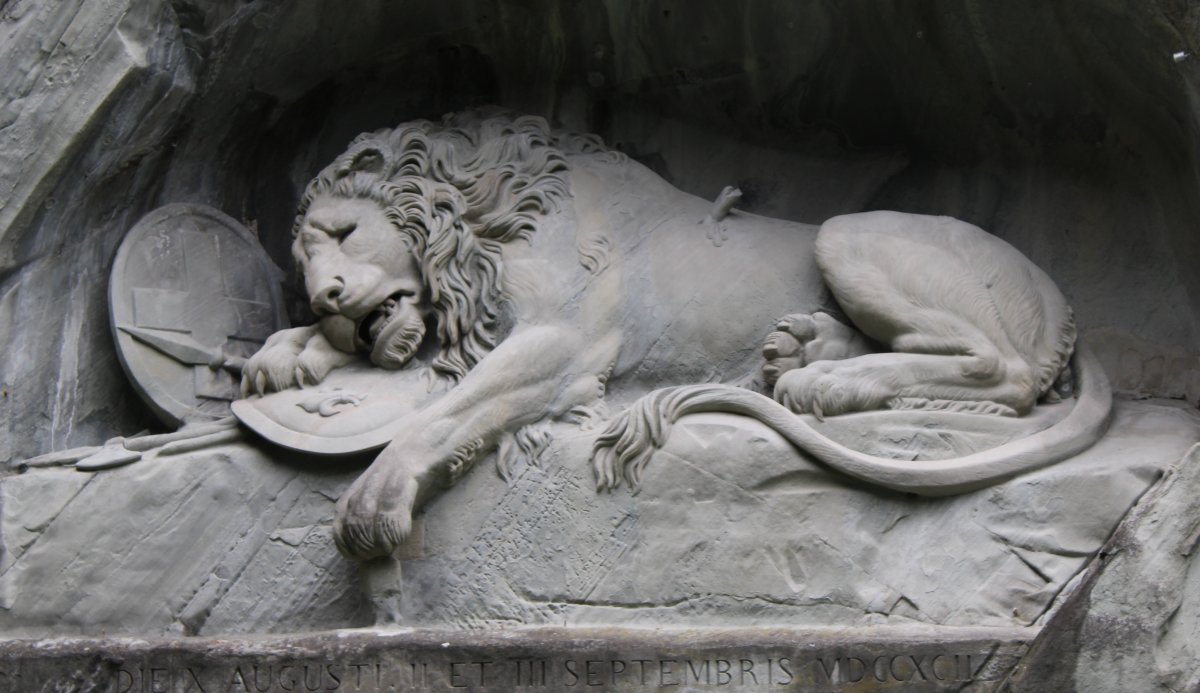 |
|
|
The inscription below the sculpture lists the names of the officers and gives the approximate numbers of soldiers who died (760), and survived (350).
Mark Twain visited here and wrote about it in his book A Tramp Abroad. He praised the sculpture of a mortally wounded lion as "the most mournful and moving piece of stone in the world."
"The Lion lies in his lair in the perpendicular face of a low cliff—for he is carved from the living rock of the cliff. His size is colossal, his attitude is noble. His head is bowed, the broken spear is sticking in his shoulder, his protecting paw rests upon the lilies of France. Vines hang down the cliff and wave in the wind, and a clear stream trickles from above and empties into a pond at the base, and in the smooth surface of the pond the lion is mirrored, among the water-lilies.
Around about are green trees and grass. The place is a sheltered, reposeful woodland nook, remote from noise and stir and confusion—and all this is fitting, for lions do die in such places, and not on granite pedestals in public squares fenced with fancy iron railings. The Lion of Lucerne would be impressive anywhere, but nowhere so impressive as where he is." - Mark Twain
|
| |
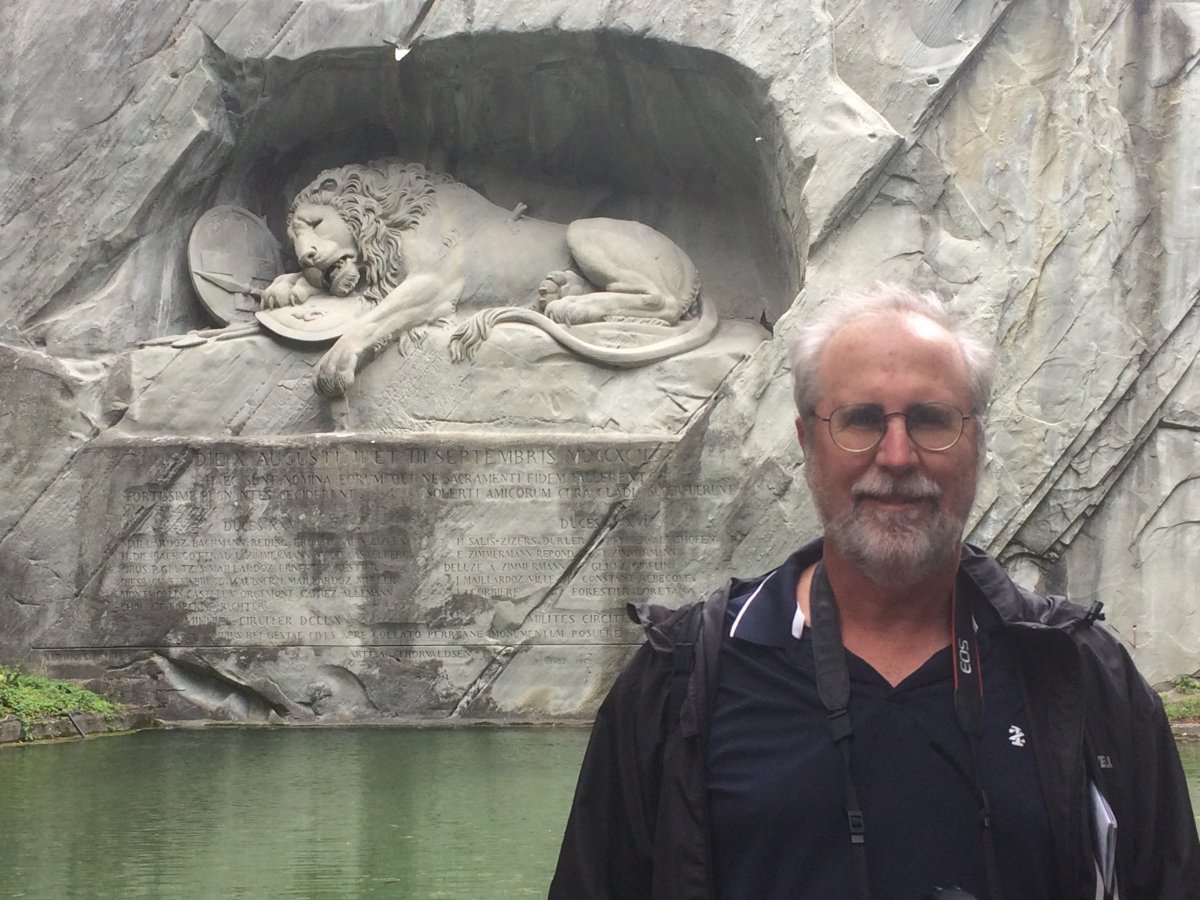 |
|
|
The Church of St. Leodegar (Lucerne). Also known as Hofkirche St. Leodegar, this Roman Catholic church was built in parts from 1633 to 1639 on the foundation of the Roman basilica which had burnt in 1633. It was one of the few built north of the Alps during the Thirty Years War and one of the largest art history rich churches of the German late renaissance period.
|
| |
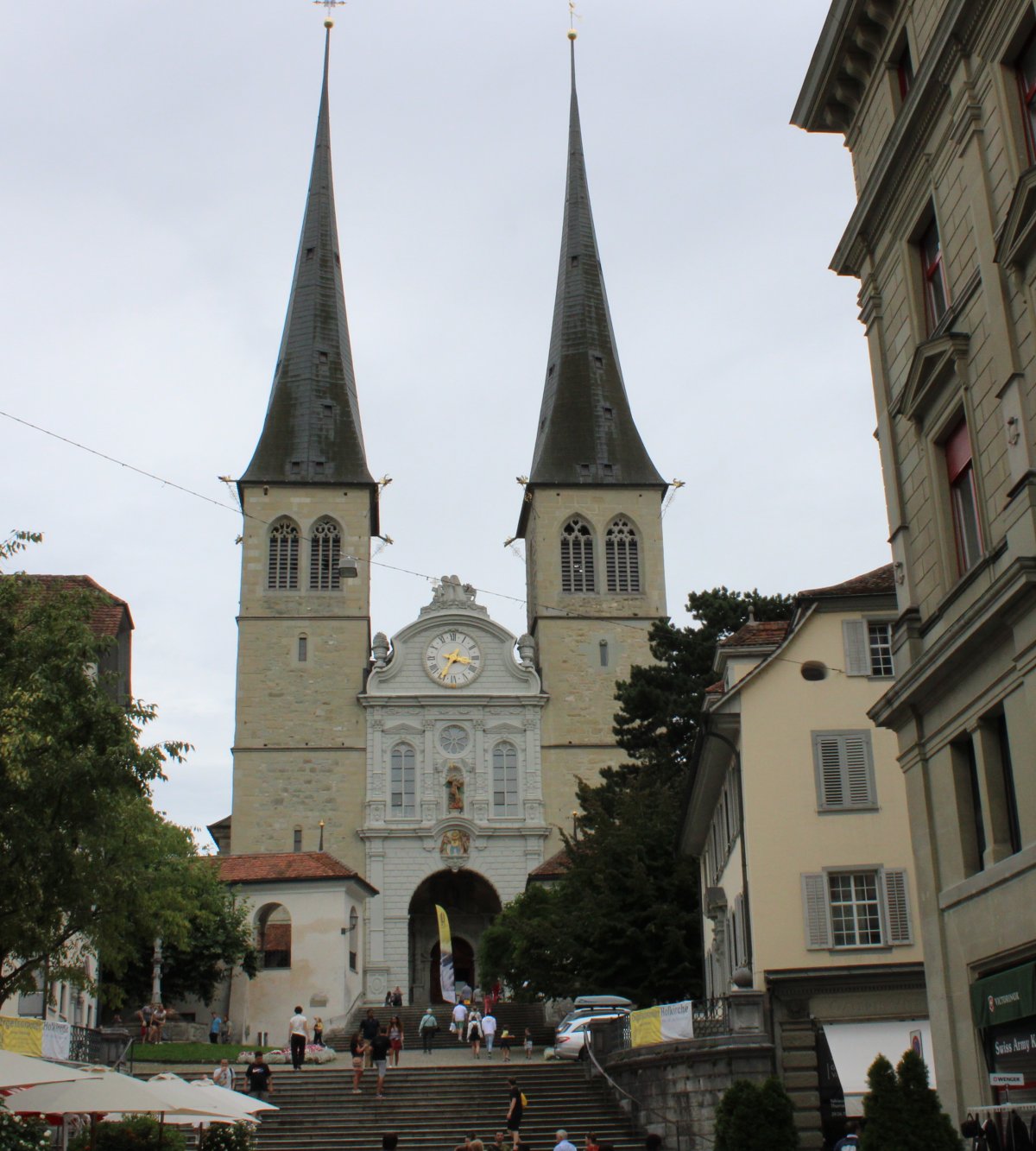 |
|
| |
| |
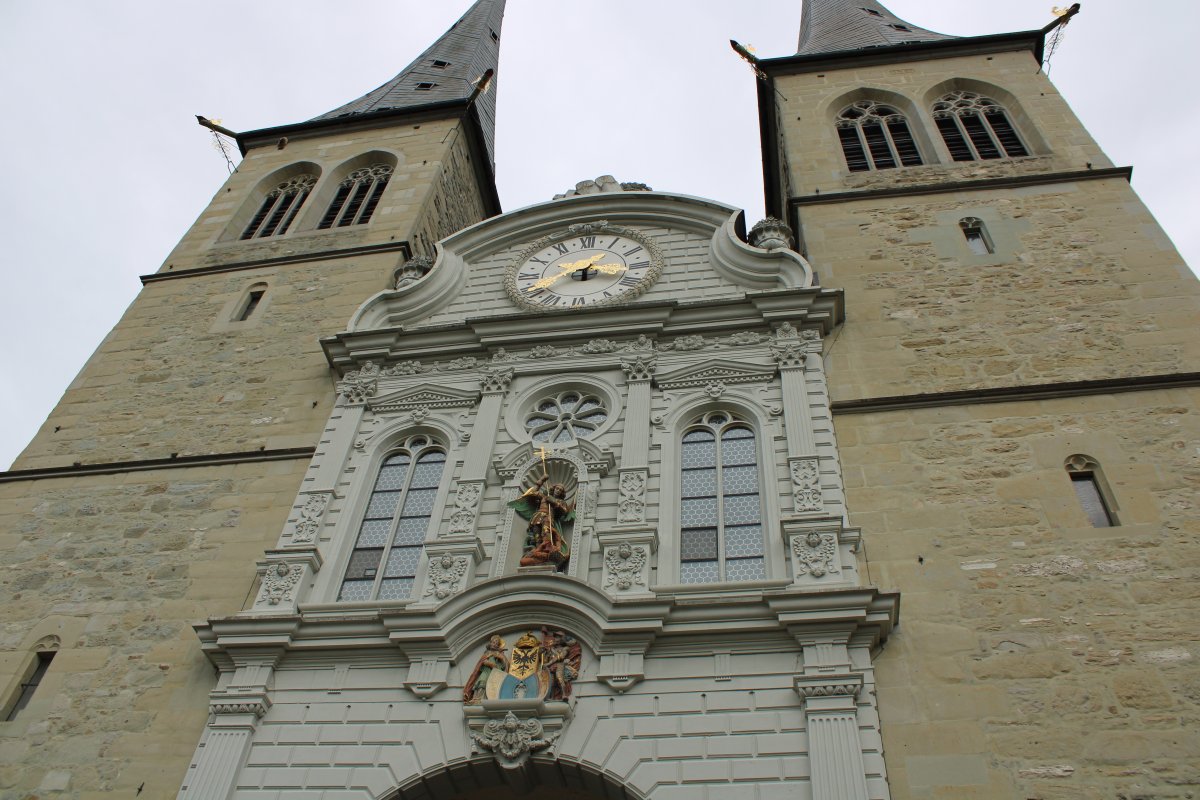 |
|
|
We took a ten minute train ride to the commuter town of Littau and checked into our B&B. Very Swiss! Notice the steep grass-covered hill on the left complete with grazing sheep.
|
| |
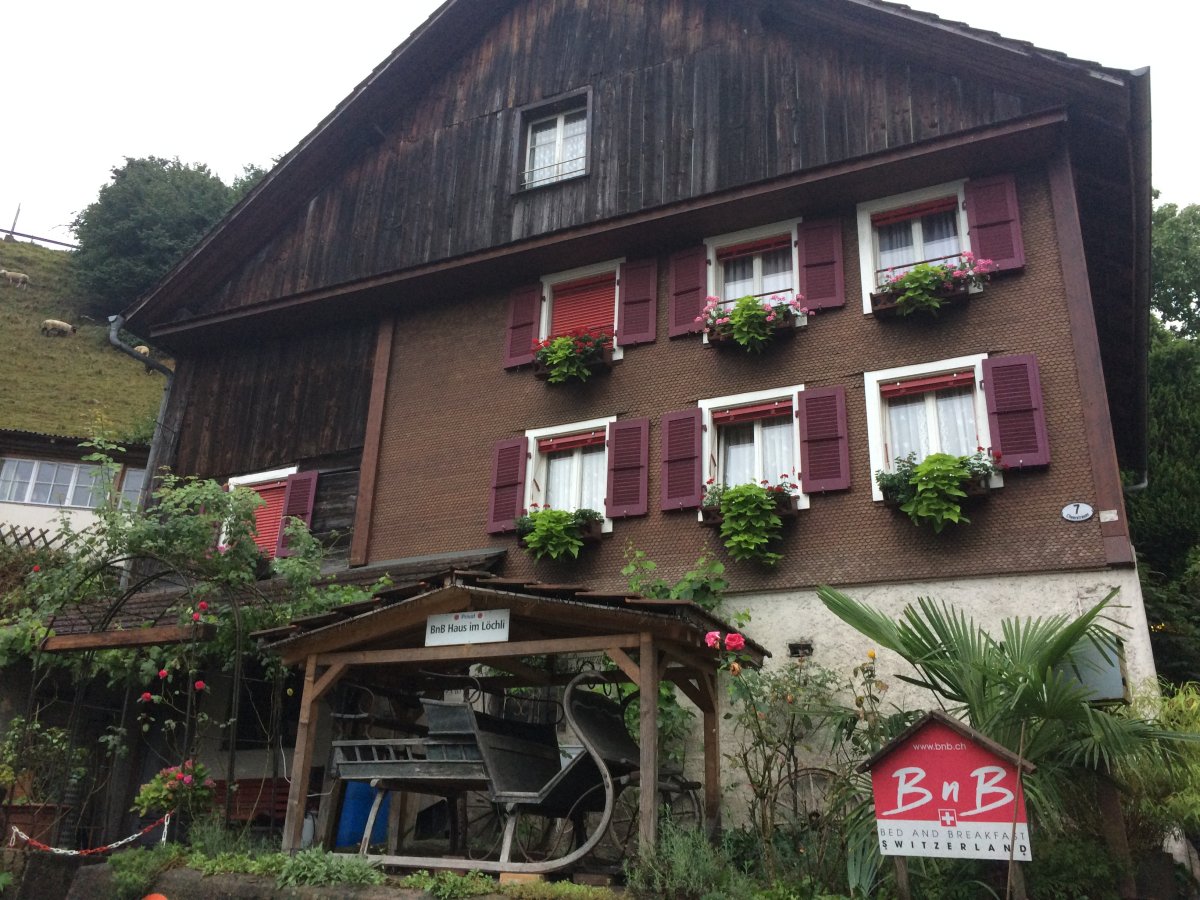 |
|
| |
| |
|
|
|
|
|
|


























